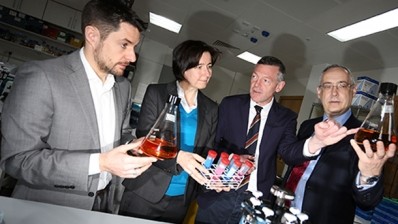Food firms challenged by musculoskeletal disorders

- Musculoskeletal disorders
- Respiratory risks
- Dermatitis: food manufacturing’s largely unreported health threat
MSD was the focus of an event hosted by the Institution of Occupational Safety and Health (IOSH) Food and Drink Group in March, after the group identified it as a significant problem in Reporting of Injuries, Diseases and Dangerous Occurrences Regulation (RIDDOR) figures from the sector.
“Health and Safety Executive [HSE] statistics show that in 2013/14 and 2014/15, the food and drink sector was responsible for 28% and 26% respectively of the total number of RIDDOR reports made across all forms of manufacturing,” says Paul Fenner, a member of the group. “Over 13% of all food and drink sector RIDDORs are attributable to MSDs.
“In the past, I have found that the prevention and management of MSDs have been seen as being too difficult to resolve. Thankfully, more and more companies are realising that investing in their workers’ health is good for both employees and their business.”
IOSH’s Food and Drink Group runs an annual awards scheme, recognising businesses that successfully address hazards and control risks in the workplace. For example, Greencore Food to Go’s Park Royal factory in London received an award last year for its partnership with a conveyor manufacturer to develop and install a new dispatch system that removes health problems associated with twisting and overstretching.
Greencore also invested £3,000 in new handles for heavy bins used to carry butter cream around its factory floor, after employees had reported back strain from stooping.
“I feel that in order to improve the situation and drive reductions in MSD risk, RIDDOR incidents and better manage employee health, we all need to educate our organisations on the importance of the ‘health agenda’, and particularly the value that will create for every organisation in the food and drink sector,” said Fenner.
“We need to integrate the assessment and management of MSDs into our organisations, from planning and developing new production lines/techniques and designing in MSD risk reduction, to the occupational health programmes we use when our employees develop an MSD problem.”
Musculoskeletal disorders (Back to top)
The injury rate in food manufacture is above average for the wider manufacturing sector, concurs occupational health specialist the ELAS Group, with the highest incidence of injuries occurring in poultry processing, followed by meat processing and the manufacture of bread, fresh pastries and cakes.
“Work-related upper neck and limb disorders are an extremely significant health and safety issue in the food and drink manufacturing sector, in fact accounting for some 23% of cases of occupational ill health,” says Danny Clarke, operations director for ELAS.
“Examples of chronic injuries include tenosynovitis and carpal tunnel syndrome, which result from repetitive tasks such as those completed on production lines. In addition, manual handling injuries — such as back injuries — account for around 35% of cases of occupational ill health, which equates to around 1,700 acute injuries per year; 60% of these 1,700 back injuries involve lifting heavy objects, such as on packing and production lines.”
The main causes of MSDs, such as backache, sore shoulders or elbows, numb or tingling wrists and hands, are stacking/unstacking containers, pushing wheeled racks, cutting, boning, jointing, trussing and evisceration, packing products and handling drinks containers, says Clarke.
There are ways in which these health risks can be mitigated by employers, including stringent engineering controls, training on the correct use of personal protective equipment and specific on-the-job manual handling training, Clarke says. “Companies should also undertake assessments of repetitive tasks that enable risks to be identified and control measures introduced,” he adds.
Ron Reid, a regulatory partner at law firm Shoosmiths, says occupational health has long been seen as a poor relation to health and safety but that is changing. “There is a misguided notion occupational health is difficult to manage,” he says. “When I’m trying to advise people on what to expect going forward, occupational health will have an increasing focus."
A few years back, the government identified specific areas of focusing attention for health and safety inspections, says Reid, among them MSDs and respiratory conditions.
With MSDs, inspections will look for compliance through “management control and suitable risk assessment”, he says. “For example, in a food manufacturing environment where there may be heavy bags of ingredients to lift, are there handling aids and sufficient instruction on lifting?”
Respiratory risks (Back to top)
And in plants where workers are at risk of developing asthma through exposure to enzymes or dust, manufacturers should ensure adequate extraction and ventilation is in place. “Those sort of things have to be maintained by a competent person,” he says.
Alongside workers handling metal, food and drink manufacture rates as having the highest incidence of occupational asthma, he says.
According to the ELAS Group, respiratory conditions such as asthma comprise 33% of food industry compensation cases made under the Department of Work and Pensions Industrial Injuries Scheme.
“Among all occupations, bakers have the second highest incidence rate of occupational asthma as reported by chest physicians, who also report that flour/grain dust is the second highest agent for causing occupational asthma,” says Clarke.
On a positive note, Reid, who has 40 years of experience advising food and drink manufacturers, believes the sector has made significant strides in addressing MSDs with increasing automation often removing problems.
“People have become more aware,” says Reid. “And there is less acceptance it was just something that went with the job.”
Dermatitis: food manufacturing’s largely unreported health threat (Back to top)
Skin conditions are a significant occupational health issue for food and drink manufacturers. HSE statistics highlight work-related dermatitis as one of the main causes of ill health for workers in the catering sector, with the number of new cases each year twice the average of all other industries.
“Occupational dermatitis is one of the most widespread causes of ill health and affects workers in many industry sectors, particularly when it comes to food processing and catering,” says Danny Clarke, operations director for ELAS, a provider of business support services including occupational health.
“Nationally, across all industries, an estimated 84,000 people have dermatitis caused or made worse by their work. The food and catering industries account for about 10% of this figure. About 40% of dermatitis cases in the industry are caused by contact with foods.
“A wide variety of foods have been shown to cause dermatitis, including sugar, flour/dough, fruits (especially citrus fruits), vegetables, spices, fish and meats. In addition, prolonged contact with water, soaps and detergents results in approximately 200 dermatitis cases being reported by occupational physicians each year.”
The Deb Group supplies skin care regimes for workplace and public environments including food manufacturing, which address skin care concerns while meeting hygiene standards.
“You can appreciate how important it is to keep hands clean in a food and drink environment,” says Chris Brooks, technical product manager at Deb. “One of the key issues in food manufacture is the frequency of cleaning. Products need to be very well balanced, not only taking away dirt but helping with the skin.”
A new Deb Stoko range was introduced earlier this year, designed specifically for occupational skin care across a variety of industries including food manufacturing and processing. Including pre-work creams, hand cleansers and after-work restore creams, the range is formulated to maximise hygiene standards while minimising risk of skin disease and stress.
A recent launch, Deb InstantFoam Complete, lays claim as the world’s first alcohol-based foam hand sanitiser proven to be fully virucidal, bactericidal and yeasticidal.
The product is said to be ideal for preventing the spread of pathogens found on raw meats and other food products, while hypoallergenic with good skin compatibility. Debs cites clinical testing, based on a high frequency usage study using 48 applications each day for five days, suggesting the product prevents skin dryness and has no adverse effect on skin condition.
Deb also provides employers and employees with training, and supporting educational materials. “Occupational skin disease is a serious health issue that goes largely unreported in the workplace, an invisible threat that affects both an organisation’s efficiency and the health and wellbeing of its employees,” says Paul Jakeway, marketing director at Deb UK.
Arco, a supplier of personal protective equipment including clothing, footwear, gloves, workplace safety and hygiene products, also highlights the HSE statistics.
Arco recommends its new Household Grip Glove to protect workers’ hands across food processing and cleaning environments, preventing direct contact with irritants or food contamination by particles.
The new glove from Arco has been food approved, while also meeting the EN 374 standard for ‘gloves giving protection from chemicals and micro-organisms’.



















